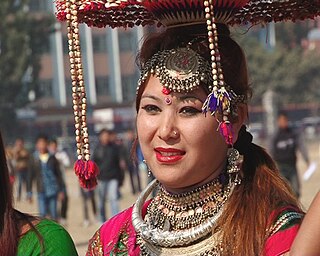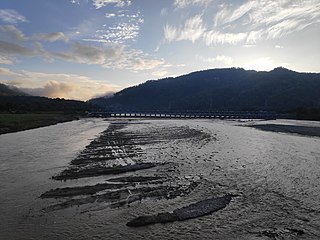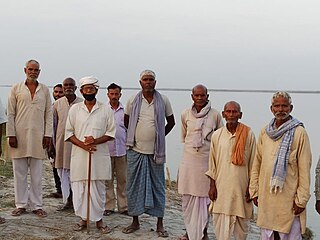
The Tharu people are an ethnic group indigenous to the Terai in southern Nepal and northern India. They speak Tharu languages. They are recognized as an official nationality by the Government of Nepal. In the Indian Terai, they live foremost in Uttarakhand, Uttar Pradesh and Bihar. The Government of India recognizes the Tharu people as a scheduled Indian tribe.

The Rai also known as Khambu and Jimee are ethnolinguistic group belonging to the Kirat family and primarily Tibeto-Burman linguistic ethnicity. They mainly reside in the eastern parts of Nepal, the Indian states of Sikkim, West Bengal and in southwestern Bhutan.

Jhapa District is a district of Koshi Province in eastern Nepal named after a Rajbanshi Surjapuri language word "Jhapa", meaning "to cover" (verb). The 2021 Nepal Census, puts the total population of the district at 994,090. The total area of the district is 1,606 square kilometres.

Sarlahi, a part of Madhesh Province, is one of the seventy-seven districts of Nepal. According to new laws, a combination of more than two or four villages makes a municipality, which covers an area of 1,259 km2 (486 sq mi) and had a population of 635,701 in 2001,769,729 in 2011 and 862,470 in 2021.

Madheshi people is a term used for several ethnic groups in Nepal living in the Terai region of Nepal. It has also been used as a political pejorative term by the Pahari people of Nepal to refer to Nepalis with a non-Nepali language as their mother tongue, regardless of their place of birth or residence. The term Madheshi became a widely recognised name for Nepali citizens with an Indian cultural background only after 1990.

Ethnic groups in Nepal are delineated using language, ethnic identity or the caste system in Nepal. They are categorized by common culture and endogamy. Endogamy carves out ethnic groups in Nepal.
The Dhimal or Dhemal are ethnic group residing in the eastern Terai of Nepal and West Bengal of India. They are a Sino-Tibetan-speaking ethnic group of the eastern Terai. They mainly reside in Morang and Jhapa districts of Nepal and Darjeeling district of West Bengal, India. They are respected as the "First Nepalese Citizens" of Damak municipality and are also Scheduled Indian tribes in West Bengal.

Dipayal Silgadhi is a municipality and the district headquarters of Doti District in Sudurpashchim Province of Nepal. Previously, it also served as the headquarters of the Far-Western Development Region. It lies in the Lesser Himalayas on the bank of Seti River. At the time of the 2011 Nepal census it had a population of 32,941 people living in 7,447 individual households.

The Tharu or Tharuhat languages are any of the Indo-Aryan languages spoken by the Tharu people of the Terai region in Nepal, and neighboring regions of Uttarakhand, Uttar Pradesh and Bihar in India.
The Chhantyal are an indigenous people of Nepal. Chhantyals are considered an indigenous group by the Government of Nepal. Most of the Chhantyal dwellings are concentrated in the western part of the country. Baglung and Myagdi are two districts in the Dhaulagiri Zone where most of the Chhantyals are living. Other districts with Chhantyal habitation include Mustang, Gulmi, Rukum, and Parbat. Nowadays, owing to the migration trend there is a notable population of the Chhantyals in Kathmandu Valley, Pokhara, Rupandehi, Kaski, Dang and Chitwan districts. According to a survey conducted by its sole organization, Nepal Chhantyal Organization, the total population is 16,093 and 1,602 households. Traditionally Chhantyals have been living with other castes in harmony. In some villages Chhantyals are a major group whereas in other villages they are a minority. Chhantyals have their own culture, tradition, rituals, language, and religion.
The Pahadi people are an Indo-Aryan group living in the hilly region (Pahad) of Nepal. Most Paharis, however, identify as members of constituent subgroups and castes within the larger Pahari community such as Brahmin, Kshatriya and Dalits.
Madi is a municipality in Chitwan District of Nepal. With the population about 50,000, it is the fifth municipality in the district. Former four village development committee serially from East to West Ayodhyapuri (अयोध्यापुरी), Kalyanpur (कल्याणपुर), Baghauda (बघौडा) and Gardi (गर्दी) are politically merged to form Madi municipality. Geologically, Madi is a valley with north facing Churevabar and remaining surrounded with Shomeshowar Mountain. It is known for several ancient religious sites. Pandavas were here in their 12 years exile. There is a village named after them, Pandava Nagar in western Madi. This is also the sacred place for Hindus as the Saga Valmiki lived here thousands years ago.

Kumal is a caste or ethnic group in Nepal, traditionally associated with pottery. Their traditional profession is endangered due to competition from cheaper, more durable industrial pots. Fewer youths learn the skills. They are found to inhabit in the Terai, inner Terai and Mid-hills close to the riverbanks where bioresearches are rich to continue to their traditional occupation. Their traditional dance, the Pangdure, is considered endangered.
Rajdhob or Rajdhov is an indigenous group of people based mainly in Terai of Nepal. In general, they are categorized as Madhesi.

Nawalpur is one of 11 districts of Gandaki Province of Nepal. The headquarters of the district is Kawasoti.
Rishing Rural Municipality (Rishing Gaupalika) (Nepali: ऋषिङ्ग गाउँपालिका) is a Gaunpalika in Tanahaun District in Gandaki Province of Nepal. On 12 March 2017, the government of Nepal implemented a new local administrative structure, in which VDCs have been replaced with municipal and Village Councils. Rishing is one of these 753 local units.

Babai Rural Municipality is a Gaunpalika in Dang District in Lumbini Province of Nepal. On 12 March 2017, the government of Nepal implemented a new local administrative structure, with the implementation of the new local administrative structure, VDCs have been replaced with municipal and Village Councils. Babai is one of these 753 local units. Babai Rural Municipality has area of 257.48 km2. Babai RM is surrounded by Shantinagar Rural Municipality and Dangisharan Rural Municipality in the east, Banke district in the west, Salyan district in the north and in south there is Dangisharan Rural Municipality and Banke district.
Darai people (Nepali:दरै) are an indigenous ethnic tribal community native to Nepal. Most of their population live in hills and inner terai of Nepal in the banks of Narayani river with the largest concentration in Tanahu, Chitwan, Gorkha and Nawalparasi districts. They are known as Daroe, Darhi, Daraie, Daras, Darad and Darai. According to census of 2021 their population is 18,695.

The Danuwar are an ethnic group indigenous to the inner Terai regions of Nepal. They speak Danwar language. Danuwars can be found throughout the hills and Terai regions of central and eastern Nepal but they mainly reside in Sindhuli and Udayapur district. They have close physical and cultural similarities with Tharus of Terai. There are various sub groups largely Rajhan, Kachhade, Rai-Danuwar and Tharu Danuwar.
The Bote people are an ethnic group indigenous to the inner Terai regions of Nepal. They speak Bote language. The Bote people are well-known for ferrying travellers across the rivers through the boats, which often are prepared from the trunks of the trees. They are scattered around the bank of Kaligandaki, Narayani and Rapti River of Nepal. Bote and Majhi people are known as the ‘King of water’. Their ancestral occupation is fishing, boating and searching gold in the river whose settlement is nearby river and forest. The dialect and culture of Bote people in several ways is similar to that of the Danuwars, Darai, Tharus and Majhi.












